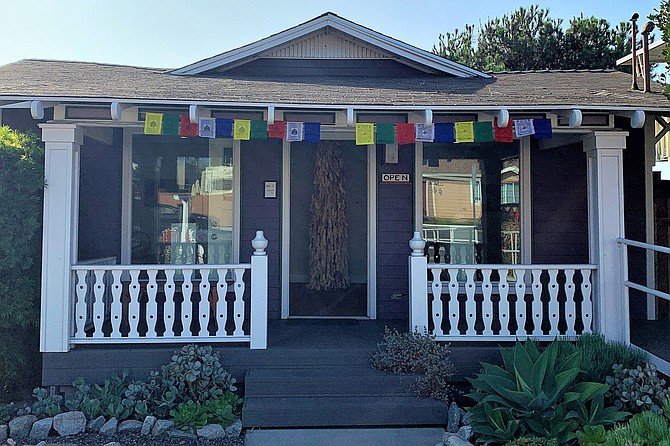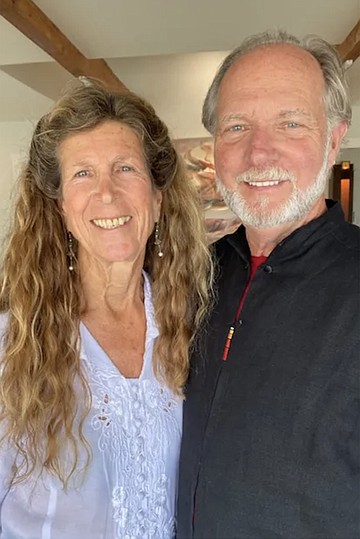 Facebook
Facebook
 X
X
 Instagram
Instagram
 TikTok
TikTok
 Youtube
Youtube

Carlsbad’s PHES Gallery is an attractive and compact building that sits on a quiet stretch of State St. close to the heart of the Village. While it is a new institution — having opened in June of 2021 — its owners, Ellen Speert and Paul Henry, have been living and creating in North County for around 30 years. The years and the work have given them the chance to build a community.
Their gallery building is attached to the furniture shop that Henry has worked in since 1981; there, he makes custom furniture as well as repairing and restoring antiques. It’s where he spends the better part of his days since retiring after two decades of teaching in the Cabinet and Furniture Technology program at Palomar Community College in 2017. For her part, Speert — a board-certified art therapist and expressive arts therapist — also runs the California Center for Creative Renewal in Encinitas.
PHES Gallery was born when the plans of the building’s previous tenants led them elsewhere. Henry and Speert saw an opportunity: both had work that they wanted to display more fittingly, and they liked the idea of creating “a place for community” — a home for art and events that would stimulate discussion. When choosing what to showcase, Speert says, “We want things that people can go away thinking about and talking about.”

Their current show is called Impermanence. Speert told me, “I think we live on many levels, and one of them is the awareness of what is happening to the earth, and to native peoples, and to the animals, and the water. All of us have some awareness of that, but we’re so busy that we try to keep that out of our day-to-day thinking. So this is a reminder.” Henry thinks that “it’s also good for the end of the year: impermanence, things change, things disappear.” Speert concluded that “with covid and all the losses people have had, it feels really relevant.”
My hosts gave me a brief tour. As we strolled through the rooms, I noticed a peculiar sort of background music: the consistent metallic rubbing sound produced by sand pouring through traditional metal funnels. That sound was made by a few Tibetan monks from the Gaden Shartse Monastery in South India, who were set up near the entrance, quietly busy building up an impressive, colorful sand mandala — destined, as they always are, for just a short period of display and consideration before being swept away. In the back of the building, I saw Kathi McCord’s pencilled Rainforest Mural, which was in the process of disappearing as guests wielded the provided eraser to remove portions of the intricate drawing. On another side of the building, photographs depicted Andres Amador’s large-scale raked sand art, made to disappear with the day’s rising tide.
Impermanence will run through February 13. Information about the talks that are part of the show can be found at phesgallery.com.


Carlsbad’s PHES Gallery is an attractive and compact building that sits on a quiet stretch of State St. close to the heart of the Village. While it is a new institution — having opened in June of 2021 — its owners, Ellen Speert and Paul Henry, have been living and creating in North County for around 30 years. The years and the work have given them the chance to build a community.
Their gallery building is attached to the furniture shop that Henry has worked in since 1981; there, he makes custom furniture as well as repairing and restoring antiques. It’s where he spends the better part of his days since retiring after two decades of teaching in the Cabinet and Furniture Technology program at Palomar Community College in 2017. For her part, Speert — a board-certified art therapist and expressive arts therapist — also runs the California Center for Creative Renewal in Encinitas.
PHES Gallery was born when the plans of the building’s previous tenants led them elsewhere. Henry and Speert saw an opportunity: both had work that they wanted to display more fittingly, and they liked the idea of creating “a place for community” — a home for art and events that would stimulate discussion. When choosing what to showcase, Speert says, “We want things that people can go away thinking about and talking about.”

Their current show is called Impermanence. Speert told me, “I think we live on many levels, and one of them is the awareness of what is happening to the earth, and to native peoples, and to the animals, and the water. All of us have some awareness of that, but we’re so busy that we try to keep that out of our day-to-day thinking. So this is a reminder.” Henry thinks that “it’s also good for the end of the year: impermanence, things change, things disappear.” Speert concluded that “with covid and all the losses people have had, it feels really relevant.”
My hosts gave me a brief tour. As we strolled through the rooms, I noticed a peculiar sort of background music: the consistent metallic rubbing sound produced by sand pouring through traditional metal funnels. That sound was made by a few Tibetan monks from the Gaden Shartse Monastery in South India, who were set up near the entrance, quietly busy building up an impressive, colorful sand mandala — destined, as they always are, for just a short period of display and consideration before being swept away. In the back of the building, I saw Kathi McCord’s pencilled Rainforest Mural, which was in the process of disappearing as guests wielded the provided eraser to remove portions of the intricate drawing. On another side of the building, photographs depicted Andres Amador’s large-scale raked sand art, made to disappear with the day’s rising tide.
Impermanence will run through February 13. Information about the talks that are part of the show can be found at phesgallery.com.
Comments